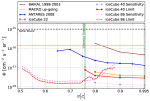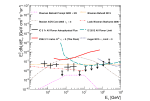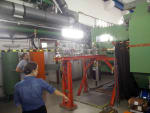In a new study by the IceCube, Pierre Auger, and Telescope Array Collaborations, scientists have looked for correlations between the highest energy neutrino candidates in IceCube and the highest energy cosmic rays in these two cosmic-ray observatories. The results, submitted today to the Journal of Cosmology and Astroparticle Physics, have not found any correlation at discovery level. However, potentially interesting results have been found and will continue to be studied in future joint analyses. […]
Research
ANTARES and IceCube, a first joint search for neutrino sources launches a future of further collaboration
New results submitted today to the Astrophysical Journal are the outcome of a combined search for neutrino point sources performed by the ANTARES and IceCube collaborations. No source has been identified, but the combined search improves the sensitivity to point sources by up to a factor of two, which delivers more stringent upper limits on the flux for the candidate sources considered in this analysis. […]
IceCube sets best limits for mildly relativistic magnetic monopoles
The IceCube Collaboration today presents a search for relativistic and mildly relativistic monopoles using two years of data. No monopole candidate was observed, but IceCube data allowed setting very stringent limits for the range of velocities studied. These results have been submitted today to European Physical Journal C. […]
On neutrino oscillations
Neutrino physicists spend a lot of time in the dark. As a figurative statement this reflects how difficult neutrinos are to understand, but it also reveals the literal sense that we work with experiments that do not see a lot of sun—and it’s not just the South Pole, it’s also in mines, tunnels, and deep underwater in seas and lakes. But just like a rare neutrino interaction, every so often a brief flash of light offers some new truth about the nature of our universe. […]
A summer of Antarctic research at UWRF
The Physics Department of UW–River Falls hosts summer internships for young college students that allow them to engage in IceCube and other polar science projects. Over the 10-week internship, they become a member of the team, where they learn to program and to tackle challenging scientific questions. And, as you will read here, they also get a chance to share their experience. […]
The tau neutrino hunt is now in full swing
Today the IceCube Collaboration has presented a search for tau neutrinos at energies above 214 TeV that, although it did not find any events, allowed setting upper limits on the astrophysical tau neutrino flux. This search sets limits on tau neutrinos at energies three orders of magnitude lower than the energies reached by previous dedicated tau neutrino searches. And more importantly, the results now submitted to Physical Review D also prove that tau neutrino searches in IceCube are reaching the sensitivity for a potential discovery. […]
Search for transient astrophysical neutrino emission using GeV muon neutrinos in IceCube
In a paper submitted today to the Astrophysical Journal, the IceCube Collaboration presents results of a search for astrophysical sources of transient neutrino emission using a sample of low-energy—30 to 300 GeV—muon neutrino events from DeepCore. Although no source is singled out, the study sets limits on soft-spectra models, such as energetic or nearby choked GRBs. […]
Our summer research experience working on PINGU with researchers at Universität Mainz
The “IRES: U.S.-European International Research Experience-Particle Astrophysics for Undergraduates” program, funded by NSF and led by the University of Wisconsin–River Falls, brought us to Johannes Gutenburg University in Mainz, Germany, this summer to work with Professor Lutz Köpke and Professor Sebastian Böser. […]
IceCube summer research experience with scientists at Ruhr Universität Bochum
International Research Experiences for Students (IRES) is a program funded by the National Science Foundation to support active participation of US undergraduates in international research projects. Laura Lusardi from New Richmond, WI, and Kelsey Kolell from Fond du Lac, WI, participated in the IRES program through UW–River Falls to work on IceCube research for the summer.
We are both third-year undergraduate students, studying physics at the University of Wisconsin–River Falls. This summer, we had the wonderful opportunity to travel to Germany through IRES to work with IceCube researchers. Even though we both ended up attending the same university, we took wildly different paths to get here. […]
Exploring new directions with DM-Ice and IceCube coincident events
When I came to Yale three years ago, I did not expect to major in physics. Yet, after taking my first class in the subject, it was not long before its fundamental nature and incredible universality had reeled me in for good. Since then, I have sought out opportunities to explore the field and learn what it really means to be a physicist. I joined Assistant Professor Reina Maruyama’s lab this past January and a few months later found myself working on DM-Ice and IceCube. Now, as I gear up for my final year of college, I am spending my summer on campus, conducting research on coincident muon events between the enormous IceCube (1 cubic km) and comparatively miniature (2,309 cubic cm) DM-Ice17 detectors. […]









